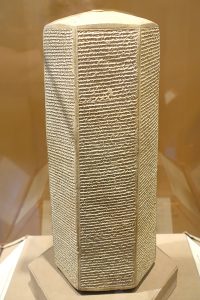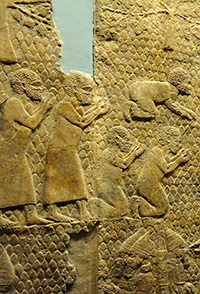

July 2021
Vol. 9, No. 7
Scholars have long sought to discern the historical cause behind what the biblical authors explain supernaturally; however, no conclusive evidence exists. One theory is that an epidemic leveled the invaders. Another is a crisis elsewhere in the empire caused Sennacherib to depart. A third suggests Judah’s King Hezekiah simply surrendered, causing Sennacherib to spare the city and him.
Aubin’s Rescue of Jerusalem pokes holes in each theory, then proposes that an army led by Taharqo, a Kushite royal, played a key role in causing Sennacherib to retreat. The reason is that, though the Bible only mentions it fleetingly, an army led by Tirhakah (i.e., Taharqo) was advancing on Sennacherib (2 Kings 19:9/ Isaiah 37:9). That is the last allusion to Taharqo; the angel then takes over. The Kushites at this time comprised the 25th Dynasty of Egypt, ruling much or all of that country from ca. 734 to 656 BCE. Taharqo would become Pharaoh in 690.
Aubin, a three-time winner of Canada’s National Newspaper Award, has no graduate degrees but a B.A. in English from Harvard. He is White, and one of his adopted children is Black; he began looking into the 25th Dynasty to tell his son about African history. Aubin constructs his thesis with six chapter-length arguments based on indirect evidence from archaeology and ancient texts. He cites more than 400 scholars and includes over 100 pages of endnotes.
As the JHS project editor, I invited specialists from a variety of related disciplines who had published on the period to assess Aubin’s theory. Several were initially skeptical when they first learned of Aubin’s thesis, but these scholars were ideal because they could impartially weigh the evidence. I asked each contributor to assess one of the six arguments in Aubin’s book that corresponded to his or her field of expertise.
Their verdicts:
- Aidan Dodson, Egyptologist at the University of Bristol, deems it a “perfectly reasonable working hypothesis” that Kush’s and Egypt’s combined forces “could have given a good account of themselves against the Assyrians.”
- Jeremy Pope, Nubiologist at the College of William & Mary, sees merit in Aubin’s view that the 25th Dynasty enjoyed a privileged commercial role in the Levant following the conflict, a position consistent with having thwarted Assyria’s attempt to assert hegemony over the region.
- Christopher Hays, a specialist on the ancient Near East at Fuller Theological Seminary, builds on Aubin’s view that a positive relationship existed between Kushites and Judahites even before 701 BCE.
- Marta Høyland Lavik, a research fellow at Stellenbosch University, reviews the Hebrew Bible’s 56 references to Kush and Kushites, agreeing with Aubin that the biblical texts written after 701 depict the African nation in what he describes as “exceptionally generous terms” — a treatment he finds consistent with gratitude for services rendered.
- Song-Mi Suzie Park, an Old Testament specialist at Austin Presbyterian Theological Seminary, assesses the demand for surrender that Sennacherib’s envoy makes to Jerusalemites, a passage in 2 Kings 18 that had been the focus of her published Harvard dissertation. Many commentators have seen the chapter as mocking the 25th Dynasty’s military reliability. Park, however, upholds Aubin’s reading that it makes a subtle parallel between the Dynasty’s reliability and YHWH’s.
- Lester L. Grabbe, emeritus at the University of Hull, is the only evaluator to have expressed prior support for a successful 25th Dynasty intervention. As a jury member, he reasserts that view, differing with Aubin only on “some details.”
- Egyptologist Alan B. Lloyd, of Swansea University, calls the Rescue of Jerusalem’s theory “well-documented and thoughtful” but rejects it because it lacks actual proof. In a response included in the JHS book, Aubin remarks that “a theory by definition lacks proof. The proper test for a theory is plausibility.”
- Assyriologist K. Lawson Younger, Jr., of Trinity International University, abstains from a verdict. The “greatest challenge” to the theory, he writes, is logistical. How, he asks, could Taharqo traverse the forbidding Sinai Desert to the Levant and do so undetected by Assyrian intelligence. Aubin responds that Egyptian armies had crossed the Sinai frequently since the 15th century BCE and that a 25th-Dynasty force had done so as recently as c. 720 when confronting an Assyrian incursion near Gaza.
It is significant that none of the contributors, including the most negative, contests any of Aubin’s six arguments supporting the theory.
The final score: One thumb down, one fence-sitter, and six thumbs up.
After millennia of obscurity, perhaps Taharqo’s army will finally get more attention, thanks to a perspective from outside academia.
Alice Ogden Bellis is Professor of Old Testament Language and Literature at Howard University School of Divinity.

